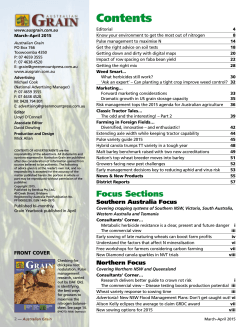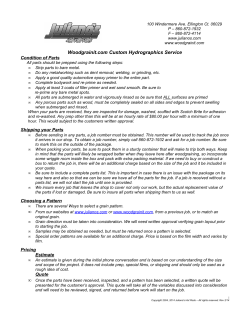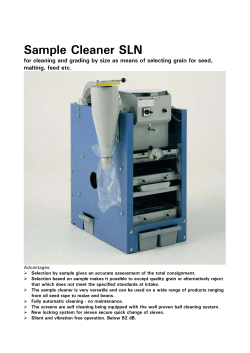
Chapter 5 Temperature
5 TEMPERA TURE Grain will be relatively warm post-har vest – ideal for insect breeding and activity. Grain is a good insulator and loses heat very slowly. BACKGROUND ISSUE Insect,mite,fungal and mycotoxin development are controlled b y temperature. At temperatures found in grain stores,biological activity of insects, mites,fungi and grain itself, doubles for every 10ºC rise in temperature. Insect breeding actually stops at lo w temperatures. Also,less moisture is available for potential pests in cold g rain. Therefore,as g rain comes into store it should be cooled immediately to pr event insects breeding. This will e ven out or equalise temperature g radients and so pr event moisture translocation. Temperature effects Cool storage extends grain storage life.It reduces germination loss,maintains baking qualities and protects against infestation. Cool storage permits grain to be stored at higher moisture contents. Lowering the temperature lowers the relative humidity in equilibrium with the mc.This effectively increases storage time. – Hot air in a continuous dr yer is likely to disinfest grain. As grain cools naturally it becomes vulnerable to infestation. – Above 40ºC,most insects die within a day. – Most insects breed rapidly at 25–33ºC.Most insect species do not breed below 15ºC but grain weevils can reproduce slowly at 12ºC. Below 5ºC insects cannot feed and slowly die. – Mites and fungi can increase (although ver y slowly) down to 5ºC in moist grain. – Mycotoxin formation is most likely between 15ºC and 25ºC. Currently, targets can be achieved in given timescales.However, if autumns become warmer this may become more dif ficult to achieve consistently. Automated temperature records Temperatures fall more rapidly and to lower levels when using automatic compared to manual fan control Permanent probe arrays can be linked to record keeping software to identify potential problems. Effect of different temperatures on insect and mite infestation risk Risk ºC 60 Least 50 40 Greatest 30 20 10 0 -10 Least -20 Effects on insects Death in minutes Death in hours Development stops Development slows Maximum development rate Risk Least ºC 60 50 40 30 Greatest Development slows Development stops but all stages survive 10 Insect death in months,movement stops (fungi can still grow slowly in damp grain) Death in weeks 0 Least Death in minutes,insects freeze 12 20 Effects on mites Death in minutes Death in hours Death in days Causes of grain heating When warm air from the centre of a bulk or bin meets cold grain at the surface,condensation may occur. Moisture at the surface or in damp pockets in the bulk will encourage moulds,heating and sprouting. Developing grain weevils may also generate heat. ACTION ● Reduce grain temperature by low volume aeration: – to below 15ºC within 2–3 weeks to prevent saw-toothed grain beetles completing their lifecycle. – to below 12ºC within 4 months to prevent grain weevils completing their life-cycle. – to below 5ºC by end-December to kill surviving adult insects and to prevent mites increasing (malting barley should not be cooled belo w 10ºC – a practice which may increase the risk of infestation). – when grain is moist,eg 15–18% mc,while it awaits drying due to har vest backlogs. EXCEPTION Dry high moisture content grain (at or above 18% mc) immediately to prevent mycotoxin formation. ● Monitor temperature regularly (every few days until target temperatures are reached,and then weekly). ● Aerate grain immediately post-harvest to even out temperatures. ● Check temperatures regularly across the bulk – particularly areas furthest away from the duct in a blown aeration system or closest in a suction system. ● Cool intermittently, even when grain temperature has fallen,to counteract ‘hot-spots’developing. No increase Maximum development rate Development slows Lowest development rate -10 Death in weeks -20 Death in minutes, mites freeze 13
© Copyright 2025












